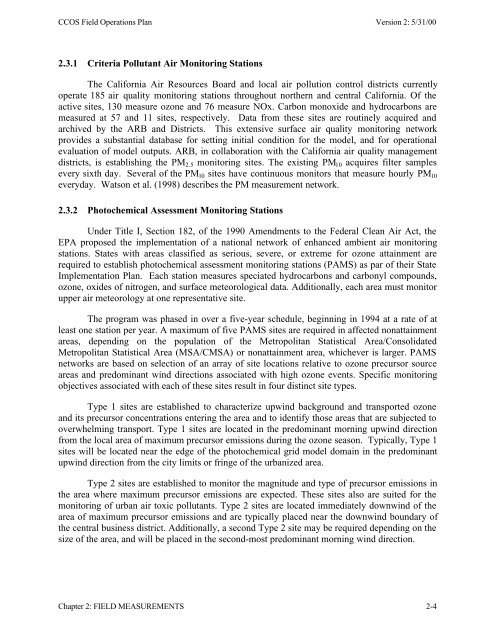Central California Ozone Study (CCOS) - Desert Research Institute
Central California Ozone Study (CCOS) - Desert Research Institute
Central California Ozone Study (CCOS) - Desert Research Institute
Create successful ePaper yourself
Turn your PDF publications into a flip-book with our unique Google optimized e-Paper software.
<strong>CCOS</strong> Field Operations Plan Version 2: 5/31/00<br />
2.3.1 Criteria Pollutant Air Monitoring Stations<br />
The <strong>California</strong> Air Resources Board and local air pollution control districts currently<br />
operate 185 air quality monitoring stations throughout northern and central <strong>California</strong>. Of the<br />
active sites, 130 measure ozone and 76 measure NOx. Carbon monoxide and hydrocarbons are<br />
measured at 57 and 11 sites, respectively. Data from these sites are routinely acquired and<br />
archived by the ARB and Districts. This extensive surface air quality monitoring network<br />
provides a substantial database for setting initial condition for the model, and for operational<br />
evaluation of model outputs. ARB, in collaboration with the <strong>California</strong> air quality management<br />
districts, is establishing the PM 2.5 monitoring sites. The existing PM 10 acquires filter samples<br />
every sixth day. Several of the PM 10 sites have continuous monitors that measure hourly PM 10<br />
everyday. Watson et al. (1998) describes the PM measurement network.<br />
2.3.2 Photochemical Assessment Monitoring Stations<br />
Under Title I, Section 182, of the 1990 Amendments to the Federal Clean Air Act, the<br />
EPA proposed the implementation of a national network of enhanced ambient air monitoring<br />
stations. States with areas classified as serious, severe, or extreme for ozone attainment are<br />
required to establish photochemical assessment monitoring stations (PAMS) as par of their State<br />
Implementation Plan. Each station measures speciated hydrocarbons and carbonyl compounds,<br />
ozone, oxides of nitrogen, and surface meteorological data. Additionally, each area must monitor<br />
upper air meteorology at one representative site.<br />
The program was phased in over a five-year schedule, beginning in 1994 at a rate of at<br />
least one station per year. A maximum of five PAMS sites are required in affected nonattainment<br />
areas, depending on the population of the Metropolitan Statistical Area/Consolidated<br />
Metropolitan Statistical Area (MSA/CMSA) or nonattainment area, whichever is larger. PAMS<br />
networks are based on selection of an array of site locations relative to ozone precursor source<br />
areas and predominant wind directions associated with high ozone events. Specific monitoring<br />
objectives associated with each of these sites result in four distinct site types.<br />
Type 1 sites are established to characterize upwind background and transported ozone<br />
and its precursor concentrations entering the area and to identify those areas that are subjected to<br />
overwhelming transport. Type 1 sites are located in the predominant morning upwind direction<br />
from the local area of maximum precursor emissions during the ozone season. Typically, Type 1<br />
sites will be located near the edge of the photochemical grid model domain in the predominant<br />
upwind direction from the city limits or fringe of the urbanized area.<br />
Type 2 sites are established to monitor the magnitude and type of precursor emissions in<br />
the area where maximum precursor emissions are expected. These sites also are suited for the<br />
monitoring of urban air toxic pollutants. Type 2 sites are located immediately downwind of the<br />
area of maximum precursor emissions and are typically placed near the downwind boundary of<br />
the central business district. Additionally, a second Type 2 site may be required depending on the<br />
size of the area, and will be placed in the second-most predominant morning wind direction.<br />
Chapter 2: FIELD MEASUREMENTS 2-4
















